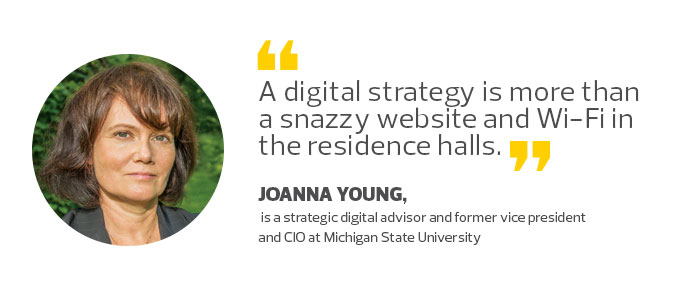Talent and Technology Are Keys to Higher Ed Success
The list of challenges facing higher education is long: At the top are state disinvestment, increasing competition for research dollars, price pressure, Title IX and new market entrants. Yet our economy depends on the success of higher ed institutions; a well-educated workforce is critical to the U.S. economy.
Our industry is poised to see a wave of integrations and closures. Moody’s predicts a tripling of college closures in coming years. Generally, the smaller the institution and the endowment, the more susceptible the college. The largest and most well-endowed institutions may feel immune, thinking they are “too big to fail.” Yet in reality, in the digital economy, no institution is immune. Leaders and boards of directors should plan today for how to transform themselves tomorrow.
The Competition Is On
Reliance on net tuition remains high, averaging more than 45 percent nationwide, 10 percent higher than during the most recent recession. Tuition is rising at rates of 7 to 8 percent, well above the inflation rate. Competition for students is increasing. In many regions (for example, the Midwest and Northeast), the number of high school graduates is declining, and many public institutions are competing for out-of-state and international students, who pay more and thus subsidize in-state students. This combination presents a challenge.
To perform well in the face of such challenges, institutions need to invest deliberately and heavily in two things: talent and technology. In particular, “top 100” institutions that pride themselves on quality of education and research should have quality of technology and talent to match.

Talent Is a Must
Institutions have long focused, and rightly so, on recruiting and retaining faculty talent, particularly faculty that can attract significant research grants. However, institutions need to invest in quality talent in all functions: lecturers, student advisers, technologists and fundraisers. Talent may come from successful new entrants in the market or institutions at the leading edge of transformation, yet they share characteristics that are key to the 21st century economy. They are change-receptive, digitally adept and customer-focused.
Students and visitors expect a top-notch experience commensurate with the institutional brand, and high-quality experience requires high-quality talent. As cost pressure increases, institutions require talent that embraces continuous improvement, whether that means reducing costs or delivering innovation that delights.
Strategically Using Tech
Technology is the second part of the equation. Institutions tend to be highly distributed, with departments that insist upon their own procedures. Unique ways of conducting specialized research are one thing. Unique ways of providing email or processing expense reports are unnecessary, sapping resources that should go to innovation.
Most institutions have a master plan for the physical campus. Leaders should focus equally, if not more, on a digital master plan. A digital strategy is more than a snazzy website and Wi-Fi in the residence halls. The strategy must be strong from the ground up, from secure, reliable infrastructure through the mobile application layer, and it should address on-premises and cloud-based systems in the full portfolio.
As many institutions are short on time as well as money, decision-making cycles must shorten. Tuition may be set annually, but decisions related to talent and technology are made constantly.
Talent, technology and time: Higher education institution leaders must focus on all three to succeed as the industry continues to transform.









